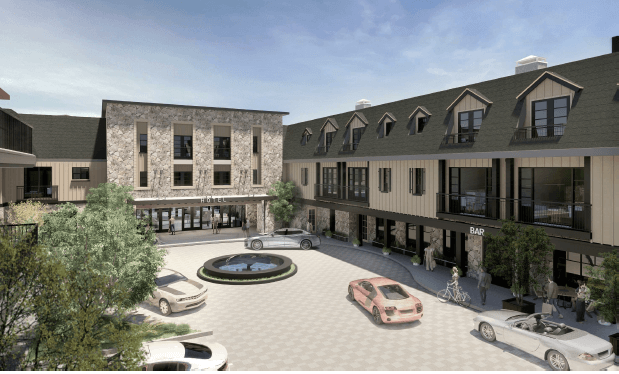In a strange twist, Kenwood Development has appealed the recent approval of its Sonoma hotel — a project it has fought 12 years for permission to build.
The Sonoma Planning Commission on October 31 approved the master plan for Hotel Project Sonoma, a 62-room luxury property just off Sonoma Plaza.
As a condition of the approval, the Commission required that $2 million be paid into the city’s Affordable Housing Trust Fund, a requirement consistent with the City’s development code.
An objection to that provision is the basis of the Kenwood appeal, which was filed on the 31st.
“The Housing Fees associated with the use permit approval are jeopardizing the financial feasibility of the project,” contends Bill Hooper, the Kenwood official that signed the appeal document.
When introduced in 2012, plans called for an 80-room hotel in the 100 block of West Napa Street, with two restaurants, event center, and underground garage. But zoning codes dictated that the parcel include an element of housing, and despite strenuous objections from Kenwood, a number of condominiums were incorporated into the design.
The revised, final plan includes eight housing units, two of which — the legal minimum — would be Affordable Housing.
It is this plan and its underlying Environmental Impact Report that the Planning Commission approved on October 19.
But in the approval, the Planning Commission required that $2 million be paid into the city’s Affordable Housing Trust Fund, with annual payments extending over a five year period, to include a payment of 5% annual interest on any unpaid balance.
It’s that stipulation that triggered the Kenwood appeal.
The city’s current development code allows for payment to the Affordable Housing Trust Fund if it finds that building the required housing on site is not feasible. Under the current code, roughly 60,000 square feet of housing would be required, matching the square footage of the commercial component.
The $2 million in-lieu fee is based on the balance of housing that is currently required.
The application for this project, however, was filed under the terms of an earlier version of Sonoma’s development code that provided the opportunity to ask for a complete waiver on any housing requirements whatsoever.
Kenwood Development did so. The company indicated that it wanted a complete waiver from any housing requirements, though housing was built into the final plan.
Kenwood estimates the project would generate for the city $1.5-million in Transient Occupancy Tax annually. Of that amount, one-thirteenth (equal to 1% of the TOT or $115,385) must be paid into the city’s Affordable Housing Trust Fund.
The total project area approved by the Commission is approximately 65,000 square feet, and includes the underground parking garage. Using an average of $1,000 cost per square foot for construction, the Hotel Project Sonoma will require funding of $65 million or more.
Using that formula, a fee of $2-million would represent 3% of the projected total construction cost.
Whether this 3% does indeed “jeopardize the financial feasibility” of the project will be up to the five-member City Council, which will hear the appeal. The panel can choose to waive the fee, change the terms, or deny the appeal outright.
The applicant could then decide to walk away from the project, sell the approved project to another developer, and/or sell the parcels involved in the project.
Given its zoning designation, if the parcels are sold, the buyer could propose another commercial project for the site, such as second and third story apartments with retail shops and restaurant on the ground floor, or an altogether different hotel.
Twelve years in process, the matter appeared to be finally settled by the Planning Commission 5-1 vote. (Chair of the commission, Larry Barnett, recused himself from the deliberations and vote; Commissioner Donna Dambach was absent).
Now the city faces the odd circumstance of an applicant appealing a decision in its favor.






Bait and switch.
I’ll bet on Anne Newmark’s comment. Strategic clawing is the essential language of such a deal.
Maybe (eh-hem) Kenwood is looking for a way out owing to financial trouble or it never penciled, especially after suffering more recent and vastly inflated costs. All the energy expended for a grandiose mirage. Just WOW !
“The applicant could then decide to walk away from the project, sell the approved project to another developer, and/or sell the parcels involved in the project. Want to bet money on which one Darius will do?” And if sold as an approved project or the parcels are sold, who will be the buyer? Could it begin with a BIG M?